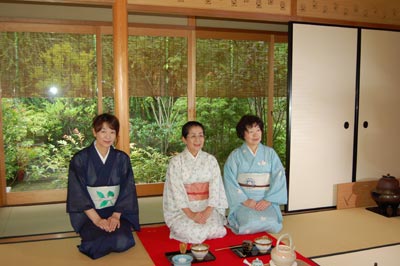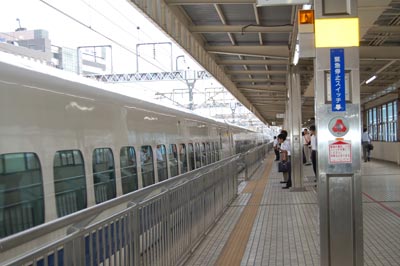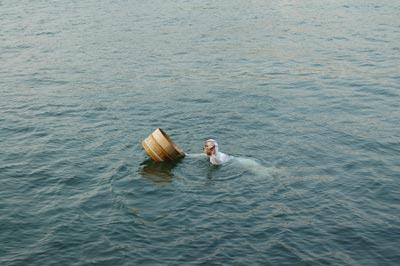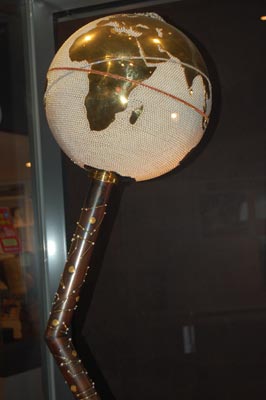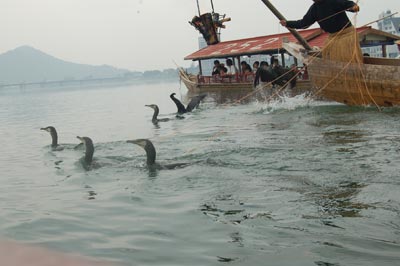Exploring Japan's Chubu region
by Noel Canfield, Contributing Editor
During the last week of July ’07, I visited four prefectures of the Chubu region, Japan’s geographic center. The Chubu region has Japan’s fourth-largest city, Nagoya; majestic mountains and ski resorts, including Nagano of the XVIII Winter Olympics; gorgeous forests; rice paddies, tea plantations and orchards; cattle ranches; amazing hot springs; the Pacific Ocean and the Sea of Japan, and stunning examples of Japan’s heritage. Chubu is Japan in microcosm.
Shizuoka Prefecture
At Nagoya’s brand-new Centrair International Airport, I met the other travelers in my group and our lovely guide, Kiko Kumazawa. Besides being well informed, Kiko was exceptionally helpful.
Our first destination was Shizuoka Prefecture (www.shizuoka-guide.com), located on the Pacific Ocean north of Nagoya. A major feature here is Mt. Fuji, which is invisible in the summer because of haziness. To see Mt. Fuji — and miss the hot humid season — it is best to visit in the fall or spring.
If you visit in the summer, bring a small, thin hand towel and keep it wet to wipe your face or put around your neck. Americans from east of the Mississippi would feel right at home in the humid heat.
Our first night was near the Kanzanji Onsen (hot springs) at the Sago Royal Hotel (phone +81 053 487 0711) in Hamamatsu City, on a peninsula between the Pacific Ocean and Lake Hamana. Lake Hamana serves mostly Japanese tourists, and, other than Kiko, no one at the hotel spoke English, not even at the front desk.
The Sago Royal Hotel (¥10,000-¥20,790, or $89-$185) was authentically Japanese. The bed was very hard and only 10 inches above the floor, but it was amazingly comfortable. On my bed lay a yukata (a cotton kimono) and obi (sash) to wear after going to the public bath (one each for men and women) or showering.
Kiko encouraged us to wear one to dinner. The available yukatas came in short, medium and tall. I needed short and round, but I did manage to wear one over my clothes.
All the hotels we stayed in had yukatas, obis and slippers for guests to wear.
All hotels also had very modern bathrooms. Thankfully, they did not have traditional Japanese toilets (ceramic rectangles in the floor which you use by squatting over them). Our “Western” toilets had heated seats and also functioned as bidets.
Our only problem at the Sago Royal was with the towels. We each got two traditional Japanese towels of about 8"x18". Kiko told us the Japanese use these as washcloths and then wring them out to pat off excess water before getting dressed. Fortunately, all the other hotels we visited had Western-style and Japanese towels.
We ate all our breakfasts and dinners at our hotels. Each breakfast was buffet style with huge selections of both Japanese and Western foods.
Dinner at the Sago Royal Hotel was magnificent. We ate in a private room and sat on pillows while our kimono-wearing waitress brought us 10 courses beautifully presented on tiny dishes. There was raw tuna, salmon, shrimp, lobster and “sweet fish”; yellow pickled radish; bean curd; steamed rice; sushi; miso soup, and more, most of which was delicious.
Our first full day in Shizuoka Prefecture, home to a number of big-name manufacturers, began in Hamamatsu City (www.city.hamamatsu.shizuoka.jp) — with a free tour (reservations required) at the Yamaha Guest Hall (phone +81 053 460 2901). We watched an interesting film about Yamaha’s history in the music field and then went to the factory and saw the assembling and testing of grand pianos.
Kakegawa Castle
Next, for only ¥300 ($2.50), we visited Kakegawa Castle (phone +81 0537 22 1146), built in 1513. An earthquake destroyed many of the complex’s buildings in 1854, and other parts later burned down. The restoration of Kakegawa Castle began in 1993, and it is the first castle in Japan to be restored entirely with wood, just as it was originally built.
The castle includes moats, gardens, the donjon (palace), the drum house, storage houses and teahouses. The palace sits on top of a rock foundation built without mortar, helping to make the palace earthquake-proof for centuries (but not fireproof).
Thankfully, we did not troop up the 1,000-plus steps to the palace, but we did walk shoeless through the drum house. First we saw a huge drum (four feet tall) used to initiate official business and ceremonies. Display cases showed miniature ancient warriors walking with their lord on horseback to pay annual homage to the shogun. One case exhibited terrifying ancient weapons.
After replacing our shoes we walked to the tea ceremony house, where we removed our shoes again. The teahouse was a small version of the drum house, but it had “furniture” — pillows to sit on and a red cloth for the ceremony. Our very tolerant tea master and her assistants guided us through the charming ceremony (¥500, or about $4, each), intended to induce peace of mind.
After the tea master poured boiling water over crushed powdered tea leaves, she demonstrated the use of a 4-inch-long bamboo stick, one end of which had been sliced 120 times into a brushy whisk.
We used our own “whisks” to whip our tea until frothy, then I slurped my tea loudly, as the tea master said slurping was good manners. While I did not like the tea (it was not like the green tea I’ve tasted at home), I loved the ceremony.
A last night in Shizuoka
The Nihondaira Ropeway ($8) is another attraction in Shizuoka Prefecture. Before reaching the ropeway, we walked up a steep slope to the viewpoint. Unfortunately, the day’s haziness obscured any view of Mt. Fuji — or anything else. Then we walked to a large visitors’ center and started down a very steep, long staircase.
Between the heat, the humidity and a recently healed broken ankle, I knew I could not manage the stairs to the gondola, thus I let the others take pictures for me of the ropeway and its goal: the Kunouzan Toshogu Shrine & Museum (¥650, or about $5.50, for a day pass).
Since Japan is the product of volcanoes and earthquakes, it is also a land of steep hills and mountains. Unhappily for elderly and/or handicapped travelers, there are no elevators, escalators or wheelchairs at many of the most popular sites.
Our next night was spent at the Shizuoka Grand Hotel Nakajimaya (phone +81 054 253 1151) in Shizuoka City. The best part of this modern hotel was dinner at its Chinese restaurant. The owner is a world-famous chef, and although we didn’t meet this fêted man we did enjoy his recipes.
By land and by sea
After seeing only a little of beautiful Shizuoka Prefecture, we left in style on the famous Shinkansen (bullet train). It was an easy walk from the hotel to the station, which was equipped with escalators.
The train was amazing. We had spacious reserved seats, and even with countryside and cities zipping by we felt no motion at all. It was a lovely ride.
After one hour and 70 miles, traveling south of Shizuoka City, we left the train at Toyohashi. Our faithful bus driver was waiting to drive us down the Atsumi Peninsula. We drove past miles of rice paddies, tea plantations and hothouses growing flowers.
Our drive ended in Irako, where we boarded the Isewan Ferry. As we crossed the Irako Channel, we spent a leisurely hour on the ferry (about $12.50 one way) and watched misty islands pass.
Mie Prefecture
In Mie Prefecture (http://welcome. kankomie.or.jp) our goal was Toba City, where we first went to Okage-yokocho street, a restored “old-fashioned” street mostly visited by Japanese tourists. It was filled with small shops selling crafts plus tiny food booths.
At lunch on Okage street I chose fried prawns — enormous, delicious and cooked. They were accompanied by rice, the ever-present miso soup and a joyously received simple salad of lettuce, tomato and mayonnaise. I was happy to have a short chair instead of a pillow to sit on plus a raised tray to hold my food on the low table.
Continuing down Okage, we came to a large plaza before reaching Uji Bridge. The bridge is the entrance to Ise Jingu Shrine, the most revered Shinto sanctuary of the 100,000 sanctuaries in Japan.
According to Shinto beliefs, people should live harmoniously with nature, and believers worship kami, the powerful spirits of nature. Some kami are enshrined in buildings surrounded by groves; others live in consecrated rocks or trees. Perhaps the most important kami is Amaterasu Omikami, and her main sanctuary in Ise Jingu Shrine is Naiku, next to the sacred Isuzu River.
Over the centuries, many sanctuaries dedicated to other kami have been added to Ise Jingu Shrine. There are now nearly 200 buildings, each of which is replaced every 20 years; the buildings were reconstructed for the 61st time in 1993.
Again, without a wheelchair I was unable to go to the shrine. Even with a wheelchair I could not have coped with some of the extremely steep stairways. I missed what over six million Japanese see each year.
Borne of the sea
From Japan’s spiritual center we went to Toba Aquarium (phone +81 0599 25 2555, www.aquarium.co.jp/english), displaying 20,000 freshwater and saltwater fish plus amphibians and mammals from all over the world. Some performed in shows, but most just swam and played.
The stars of the aquarium were two huge white dugongs, the “mermaids” of the Indian Ocean. Dugongs are mammals similar to manatees (also housed at the aquarium), except they live in salt water rather than in rivers and are pure white, not dark gray.
The Toba Aquarium was well worth the ¥2,400 ($20) admission price. There are fascinating educational displays with descriptions in both Japanese and English.
From this marvelous demonstration of nature’s splendors we went to Mikimoto Pearl Island (phone +81 0599 25 2028), where nature gets a little help from man. After crossing an enclosed bridge to the island, we walked through manicured gardens to an exhibit about cultured pearls (entry ¥1,500, about $12.50). In 1893 Kokichi Mikimoto was the first person to make cultured pearls.
Having learned how pearls are created, we then watched jewelers sort them and were shown a menagerie of spectacular art objects decorated with cultured pearls.
Our pearl adventure continued as we watched ama, or divers, in traditional white “swimsuits” dive for oysters from a boat. The 1,300 ama in Japan average 72 years of age, and most are women, as they can tolerate cold temperatures better than men.
Finally, we went to the showroom where there were pearl jewelry and art pieces for sale.
Our hotel in Mie Prefecture was Hotel Toba Senpokaku (phone 0599 25 3151, www.webem.jp/tobacci/eng/senpokaku). Again, my room was beautiful, but different. The modern, clear-glass shower and a bright yellow round tub (2½ feet tall and in diameter) were on the balcony! Even though there was a 3-foot screen covering the railing, it took me a while to feel daring enough to shower “in public.” I was in all my glory before a beautiful view of tree-covered hills.
After my risqué shower, we gathered for another beautiful traditional Japanese dinner, with a surprise. In the middle of dinner, the waitress lit candles under the abalone shells at each place setting. My live abalone started sizzling and writhing. After watching this, I couldn’t eat the abalone, even if it was a special, expensive “delicacy.”
Aichi Prefecture
Our next jaunt was in Aichi Prefecture (www.pref.aichi.jp/global/en). Sitting at a long, low table with a charming group from Okinawa, we took a marvelous barge ride on the Kiso River in Inuyama. It was very misty, creating an enchanting fairy-tale feeling.
We floated down the river and ate the best box lunch I have ever had. It cost only ¥3,800 ($33) for this super lunch, the boat ride and the next activity — one of my favorites.
While drifting down the misty river we watched ukai, or cormorant fishing, a Japanese custom since at least A.D. 700. These trained birds dive only for ayu (sweetfish) and live as members of the fishing master’s family. This is apparently good for them; wild cormorants live for only four or five years, while trained ones can live up to 20 years.
Three fishermen rode in a canoe-like boat with a fire basket on the prow to attract the fish, since cormorant fishing often is done at night. One man rowed, one steered and the third was the fishing master, dressed in a koshimino, or straw skirt, to protect him from water splashes.
The fishing master controlled 10 strings attached to the birds’ necks. The strings were just tight enough to keep the birds from swallowing large fish. When the master saw that a bird had a fish, he pulled it onto the edge of the boat and pushed up on its neck until the fish fell out.
If the birds stop diving, the steersman bangs his oar on the boat, making a loud, booming sound. The birds respond by diving heartily. The cormorants seemed so happy and excited to show off.
Our next stop in Aichi Prefecture was at Inuyama Castle, high above the Kiso River where the cormorants fish. Touring requires advance reservations (phone +81 0568 61 1711) and costs ¥500 ($4).
Gifu Prefecture
From Inuyama we headed north for Gifu Prefecture (www.pref.gifu.lg.jp). Both the road and the scenery were magnificent. We drove on an expressway through lengthy tunnels and over valleys on bridges over a hundred feet above the ground.
We passed over villages nestled in the valleys between the beautiful, majestic Hida Mountains, part of the Japan Alps National Park. We were driving through cattle country, so it was only natural to stop for a creamy vanilla ice cream cone. This is also an area of ski resorts, and we could see a ski lift on a nearby slope.
We soon were in Takayama City (www.hida.jp) at the beautiful, modern Hida Hotel Plaza (phone +81 0577 33 4600, www.hida-hotelplaza.co.jp). Made up of three wings, the hotel is half traditional Japanese and half Western. I had a lovely European-style room in the south wing.
As did most of the hotels, the Hida Plaza had several restaurants. We were fortunate to dine at Bonjour, a French restaurant. We had course after course of delicious, not exactly French food, including wonderful Hidagyu, or Hida beef. Although not as well known as Kobe beef, the Hida beef was as good and tender as the Black Angus my father raised.
We began touring Takayama by walking to the asa-ichi, or morning market, on the banks of the Miyagawa River. On one side of the walkway shops displayed their wares; on the river side, women sold local produce, flowers and handicrafts under awnings, as they have for over 200 years.
We were soon in Furui-Machi-nami, a neighborhood of 200-year-old preserved houses. Today small shops, sake breweries and restaurants line the old streets, which are adorned by pots of morning glories, wisteria and other colorful flowers.
Next was a duo of amazing exhibits (entry, ¥820, or $7) at the Sakurayama Hachiman Shrine. First was the Takayama Matsuri Festival Exhibition Hall (phone +81 0577 32 5100), a rotating exhibit of four of the 11 yatai (floats) of the Takayama Autumn Festival, held annually on Oct. 9-10.
The festival began in the mid-1600s to celebrate craftsmanship. Competition resulted in the final incredible floats, which are 20-plus feet tall with lacquered, intricate carvings and decorative metalwork both outside and inside. Four of the floats have puppets and each float can require up to eight puppeteers. During this festival and the similar Spring Festival (April 14-15), costumed men pull the floats through the town.
Hotel reservations are nearly impossible to get during the Autumn Festival, and rooms are usually available for only one night during the Spring Festival. Clearly, it is vital to plan ahead to see either of these celebrations.
The second wonderful exhibit at the shrine was the Nikko Kan, which displayed 1:10-scale models of buildings in the Nikko Toshogu Shrine near Tokyo. It took 33 carpenters 15 years, starting in the 1910s, to make the models of the 28 buildings in the exhibit. Artificial sunsets and sunrises dramatically highlight the buildings. Each miniature display includes an explanation in both English and Japanese.
Our next tour in amazing Takayama was the Jinya, or government house (phone +81 0577 32 0643). For only ¥420 ($3.50), we saw the local administrative center of the Tokugawa shogunate.
The story of the Takayama Jinya helped clarify the meaning of the models we saw at the Nikko Kan; they are models of the temple created to enshrine Tokugawa Ieyasu, the founder of the Tokugawa shogunate.
In 1603 the Tokugawa family created a new capital in Edo (Tokyo), far from the old capital in Kyoto. The Tokugawa shogunate lasted until 1868, followed by the Meiji Restoration that marked the elimination of the shogunate, the reinstatement of the emperor and the beginning of Western influence.
The Jinya was full of interesting details, one of which was the 3'x3' “sandbox” used by the local shogun to write rough drafts before a secretary wrote final drafts of his edicts. Throughout the Jinya there are tiny metal rabbits to hide the heads of nails; they also entice the spirits of rabbits to help prevent fires.
The most ghoulish but fascinating room of the Jinya was the shirasu, or courtroom. The floors of shogunate courts were made up of loose stones or sand to make it easy to clean up the blood of tortured prisoners. If the crime concerned an issue involving more than the local area, there was a basket in which to carry the evil-doer to Tokyo.
Another fascinating site in Takayama was the Hida no Sato Folk Village (phone +81 0577 34 4711). All the buildings in this village were built during the 1600s and 1700s and were moved to the Folk Village to preserve them and to illustrate the cultural heritage of the area.
The village included houses, shrines and other buildings of the shogunate era. Inside the houses were displays of over 5,000 old tools, arts and crafts.
Because of heavy snow, the roofs are very steep and made of 2-foot-thick thatch; they are replaced on a revolving schedule every three years.
As we were leaving the village, we were fortunate to catch the performance of a kumi-daiko, a drum-and-pipe ensemble with taiko drums. The Japanese have used the large drums for centuries to encourage samurai in battle, to frighten enemies, to worship kami and to celebrate festivals.
After a vastly busy morning, it was lunchtime. Half the group went to a Japanese restaurant to enjoy Hida chuka (a type of ramen dish), Hida soba (buckwheat noodles) or hoba miso (a soybean paste with beef or vegetables grilled on a magnolia leaf), at a cost of $6 to $16.
I went with Kiko to a bagel restaurant called If. It was glorious to eat a lox-and-cream cheese bagel sandwich with mango juice. If was in one of the restored old houses in Takayama proper. Inside, it looked like an old British inn.
Nagoya
After another drive through picturesque mountains, we were back in Aichi Prefecture, headed for Nagoya. We drove to the back of Nagoya Castle, where a man was waiting for us with a wheelchair. Kiko had arranged this terrific surprise for me when she made reservations for our visit, so I was regally seated while we went through the castle’s gardens and teahouse. (The teahouse requires advance reservations and costs about $4.50 for a cup of tea and sweets.)
Nagoya Castle is also part of the Tokugawa shogunate history we encountered in Takayama. Tokugawa Ieyasu ordered the castle to be built for his child Yoshinao and the Owari Tokugawa clan. It was finished in 1612, burned down in 1945 during World War II and was rebuilt in 1959. It wasn’t opened to the public until 1997.
The third and fifth floors of the donjon comprise a museum and amusement center (entry, ¥500, or $4).
Our last night in Japan was at the business-oriented Nagoya Kanko Hotel (phone +81 052 231 7711, www.worldhotels.com/japan/nagoya/hotel_ngonag.html). Breakfast the next morning was outstanding.
The final day
My last day in Japan began with a quick visit to the steps of Osu Kannon, a Buddhist temple moved from Gifu Prefecture to Nagoya in 1612. We were fortunate to see the flea market in front of the temple, held only on the 18th and 28th of each month. From there we walked to Osu Shotengai, a huge shopping arcade where they sell almost everything. There also are food stands, such as Jerry’s Uno which sells “tacos and beer,” and excellent restaurants.
We ate lunch at Hitsumabushi, in the arcade. The starter was octopus tentacle prepared in a tasty sauce. The rest of the meal was fairly typical.
Our final destination was the Morita Aji no Yakata (phone +81 0569 37 0733), a 160-year-old sake brewery and museum. After visiting the tasting room, where there were displays of different kinds of sake, we saw the brewery (free, but advance reservations are required).
The brewery functions only a few months a year, after the rice is harvested, so we didn’t actually see sake being made. Nevertheless, the tour was fascinating.
Sadly, my trip to Japan was over way too soon.
Recommendations for a Japan visit
Shoes — Bring walking shoes that can be easily removed, as historical sites and restaurants require that you remove them.
Food — Be prepared for countless raw fish dishes. Also, appearances can be deceptive; what I thought was squash turned out to be pickled radish.
Transportation — I don’t advise driving independently in Japan. Many road signs are in Japanese and English but may be confusing because many Japanese place names appear to be similar. Public transportation is excellent; trains and buses go almost everywhere and day and week passes are very reasonably priced.
Discounts — The free Tokai Welcome Card (http://j-heartland.com) provides discounts for hotels, restaurants, shops, tourist attractions and transportation in the prefectures discussed in this article.
Noel’s trip was paid for by the Japan National Tourist Organization (One Rockefeller Plaza, Ste. 1250, New York, NY 10020; 212/757-5640… or 515 S. Figueroa St., Ste. 1470, Los Angeles, CA 90071; 213/623-1952, www.japantravelinfo.com).



